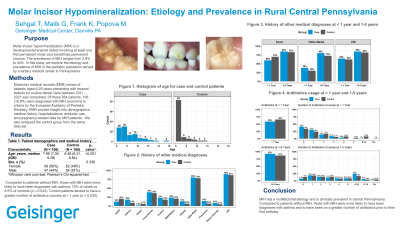Growth & Development
246 - Molar Incisor Hypomineralization: Etiology and Prevalence in Rural Central Pennsylvania


Tanya Sehgal, DMD (she/her/hers)
Pediatric Dental Resident
Geisinger Medical Center
Geisinger Medical Center
BLOOMSBURG, Pennsylvania, United States- KF
Katie Frank, Analyst
Geisinger Medical Center
- GM
Gayatri Malik, DMD, PhD
Associate Program Director
Geisinger Medical Center, Danville, PA
Danville, Pennsylvania, United States - MP
Maya Popova, DMD, PhD
Geisinger Medical Center
- GM
Gayatri Malik, DMD, PhD
Associate Program Director
Geisinger Medical Center, Danville, PA
Danville, Pennsylvania, United States - NS
Natalie Stinton, DMD
Program Director
Geisinger Medical Center, Danville, PA
Danville, Pennsylvania, United States
Presenting Author(s)
Co-Author(s)
Research Mentor(s)
Program Director(s)
Purpose: Molar incisor hypomineralization (MIH) is a developmental enamel defect involving at least one first permanent molar and sometimes permanent incisors. The prevalence of MIH ranges from 2.8% to 44%. In this study, we explore the etiology and prevalence of MIH in the pediatric population served by a tertiary medical center in Pennsylvania.
Methods: Electronic medical records (EMR) review of patients aged 6-25 years presenting with enamel defects for routine dental visits between 2011 – 2021 was completed. Of these 564 patients, 106 (18.8%) were diagnosed with MIH according to criteria by the European Academy of Pediatric Dentistry. EMR provide insight into demographics, medical history, hospitalizations, antibiotic use, and pregnancy-related data for MIH patients. We also analyzed the control group from the same data set.
Results: A total of 106 patients with MIH and 106 patients without MIH were reviewed. No significant differences observed for most demographics and medical history variables compared. However, case patients tended to be older than control patients: median age 7.99 years and 6.48 years, respectively (p < 0.001). Compared to patients without MIH, those with MIH were more likely to have been diagnosed with asthma: 18% of cases vs. 8.5% of controls (p = 0.043). Control patients tended to have a greater number of antibiotics courses at < 1 year (p = 0.035).
Conclusion: MIH has a multifactorial etiology and is clinically prevalent in central Pennsylvania. Compared to patients without MIH, those with MIH were more likely to have been diagnosed with asthma.
Identify Supporting Agency and Grant Number: Research supported by Geisinger Medical Center.

.jpg)